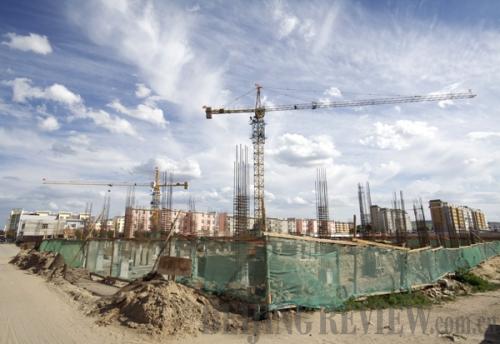|
 |
|
URBAN CHANGES: City construction in Inner Mongolia, China(MAYA REID) |
The world is becoming increasingly urbanized. In Africa and China, more and more people are migrating to cities in hopes of finding better work and education opportunities for themselves and their families. But this growth is not always positive. It's often accompanied by a decrease in quality of life for urban denizens, as the stresses of crowding, noise, pollution and job competitiveness begin to take their toll. At the same time, the variety inherent in city life is appealing and a major perk of living in a metropolis.
The question is, which is more powerful: Do the negatives of urbanization outweigh the positives or vice versa? Is there potential for happiness in spite of the misery city life can perpetuate? Tao Xidong, an associate research fellow at the Social Survey Center of the Shanghai Academy of Social Sciences, and Gerald Chungu, a lecturer at the University of Witwatersrand's School of Architecture and Planning in Johannesburg, discuss.
A Road Toward Balanced Urban Development
by Tao Xidong
Historically, the city has been a symbol of civilization and progress in human society. Since 4500 B.C. when the first cities of Mesopotamia emerged, the change from nomadic life to settled life brought with it various city models and modes of urban development. It is estimated that by 2050, nearly 70 percent of the world's population will dwell in cities.
From a global perspective, people are increasingly faced with greater challenges from urbanization. Tensions over resource scarcity, pollution, overcrowding, traffic congestion, the high cost of living, declining quality of life, social unrest and natural disasters grow by the day. In big cities such as Beijing and Shanghai, commuting to work is a big headache (especially during rush hour), migrant populations don't have equal access to public services, and high housing costs drive away many young people.
Giving a second thought to the above issues: What kind of city should we build? What kind of city makes life better? What kind of road toward urbanization should be taken?
I was born and grew up in a small inland town in west China. Later I moved to Shanghai on the eastern coast to further my studies, and finally settled there. I also visited Singapore and cities in Cambodia. Based on my personal experiences and observations, I would like to share some thoughts.
Urbanization processes vary across the world. One country varies from another, and even one region can differ from another in terms of development. Therefore, local conditions should be taken into account when choosing urban development strategies – and we should take the initiative to learn from the experiences of other countries. Singapore, for example, is a good model to learn from, as it has done especially well with its housing system, traffic controls, urban management, and many other sectors.
The city and countryside can be complementary and integrated, rather than contradictory. With its natural beauty, the countryside always has unique appeal. Living in the hustle and bustle of city, I personally prefer the quiet of the country. In my view, to accelerate rural development, building an integrated urban and rural system for public and social services should be at the core of China's urbanization efforts.
The meaning of urbanization needs to be better understood. Urbanization goes far beyond population shifts from rural areas to cities; its meaning includes giving rural residents denizen status and equal access to public service to promote a more integrated urban system.
We should build a fair city. An ideal city would be an open and inclusive place, where the needs of the rich, the poor and the disadvantaged (such as the disabled, seniors and children) are all satisfied. Everyone should have access to basic public services like education, medical care, social security, employment and housing. Everyone should have the chance to nurture creativity without worries.
Balance is important. Balancing economic and social development – and balancing economic growth with ecological sustainability – can be done in such a way that joint development between China's big cities and small towns is promoted. Creating a balance between downtown and suburb, between city and countryside, and between urban innovation and resource protection is something to strive for. Hopefully, the problems that accompany urbanization can be solved through joint efforts. Each of us should be able to enjoy a happier life in a better city in the years to come.
|